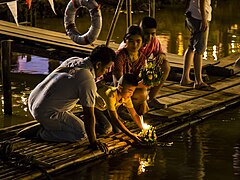| Loy Krathong | |
|---|---|
 Floating krathong in Chiang Mai | |
| Official name | Loy Krathong[1] |
| Observed by | Thailand, Laos (as Boun That Luang), northern Malaysia, Shan in Myanmar, and Xishuangbanna in China, Myanmar (as Tazaungdaing festival), Sri Lanka (as Il Poya), Cambodia (as Bon Om Touk, China (as Lantern Festival), |
| Type | Asian |
| Significance | Worship and ask for forgiveness from Goddess of water Ganga, worship the Buddha's hair pagoda in the heaven[2] |
| Date | Full moon of the 12th Thai month |
| 2023 date | 27 November[3] |
| 2024 date | 15 November[4] |
| Frequency | Annual |
| Related to | Tazaungdaing festival (in Myanmar), Mid-Autumn Festival (in China),, Bon Om Touk (in Cambodia), Il Poya (in Sri Lanka), Boita Bandana (in Odisha, India) |
Loy Krathong (Thai: ลอยกระทง, RTGS: Loi Krathong, pronounced [lɔ̄ːj krā.tʰōŋ])[a] is a Thai festival celebrated annually throughout Thailand and in nearby countries with significant South Western Tai cultures (Laos, Shan, Mon, Tanintharyi, Kelantan, Kedah, and Xishuangbanna). The name could be translated as "to float ritual vessel or lamp," and comes from the tradition of making krathong or buoyant, decorated baskets, which are then floated on a river. Many Thais use the krathong to thank the Goddess of Water and River, Goddess Khongkha (Thai: พระแม่คงคา) This festival traces its origin back to India.[5][6]
Loy Krathong takes place on the evening of the full moon of the 12th month in the traditional Thai lunar calendar, thus the exact date of the festival changes every year. In the Western calendar this usually falls in the month of November. In Chiang Mai, the festival lasts three days, and in 2024, the dates are 15-16 November.
In Thailand, the festival is known as Loi Krathong. Outside Thailand, this festival is celebrated under different names, including Myanmar as the "Tazaungdaing festival", Sri Lanka as "Il Full Moon Poya", China as "Lantern Festival" and Cambodia as "Bon Om Touk".[7][8][9][10][11]
- ^ "ประเพณี ลอยกระทง" [Loi Krathong tradition]. Ministry of Culture (in Thai). 22 January 2015. Archived from the original on 28 July 2020. Retrieved 10 November 2019.
- ^ ธนากิต. ประเพณี พิธีมงคล และวันสำคัญของไทย. กรุงเทพฯ : ชมรมเด็ก, ๒๕๓๙.
- ^ "วันลอยกระทง 2566 วันที่เท่าไร มีจังหวัดไหนจัดงานบ้าง". Thairath (in Thai). 8 November 2023. Archived from the original on 14 November 2023.
- ^ "Loi Krathong Festival 2022". Tourism Authority of Thailand. 28 October 2022. Archived from the original on 28 October 2022.
- ^ Argawal Ruchi (January 2009). "Water Festivals of Thailand: The Indian Connection". Silpakorn University Journal of Social Sciences, Humanities, and Arts. 9–10 (1): 1, 17.
- ^ Melton, J. Gordon (2011). "Lantern Festival (China)". In Melton, J. Gordon (ed.). Religious Celebrations: An Encyclopedia of Holidays, Festivals, Solemn Observances, and Spiritual Commemorations. ABC-CLIO. pp. 514–515. ISBN 978-1-5988-4206-7. Retrieved 15 February 2014.
- ^ The Penguin Handbook of the World's Living Religions. Penguin UK. 25 March 2010. ISBN 9780141955049 – via Google Books.
- ^ "Buddhist Calendar - Southeast Asian Calendars - Thai Calendar".
- ^ "Pictures of the day: 23 October 2016". The Telegraph. 23 October 2016.
- ^ "Il Poya". 12 September 2014. Archived from the original on 7 November 2017. Retrieved 26 December 2016.
- ^ "Discover the full moon festival of Cambodia, Thailand and Myanmar". 1 February 2017. Archived from the original on 1 February 2017.
Cite error: There are <ref group=lower-alpha> tags or {{efn}} templates on this page, but the references will not show without a {{reflist|group=lower-alpha}} template or {{notelist}} template (see the help page).